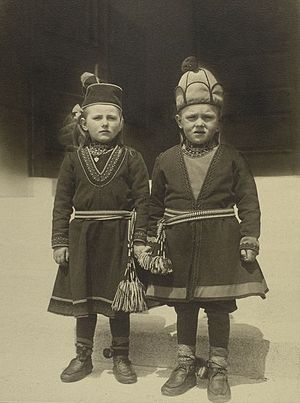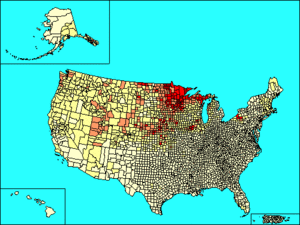Swedish Americans

Swedish Americans are U.S. Americans with Swedish heritage, most often related to the large groups of immigrants from Sweden in the late nineteenth century and early twentieth century. Most likely, about 8 million Americans have Swedish roots, of whom 4.5 million have been confirmed as Swedish Americans. Most Swedish Americans are Lutherans affiliated with the Evangelical Lutheran Church in America or Methodists.
The few inhabitants of the Swedish colony of New Sweden (in existence 1638-1655) intermarried with other colonists and seem to have disappeared as a distinctive grouping before 1776. The Swedish immigrants that arrived in recent decades settled mostly in the suburbs of New York and Los Angeles.
A few small towns in the U.S. have retained a few visible Swedish characteristics. Some examples include Silverhill, Alabama; Lindstrom, Minnesota; Karlstad, Minnesota; Lindsborg, Kansas; Gothenburg, Nebraska; Andover, Illinois; Kingsburg, California; and Bishop Hill, Illinois. Around 3.7% of the U.S. population is said to have Scandinavian heritage (which also includes Norwegian Americans, Danish Americans, and Icelandic Americans). At present, around 160,000 residents speak a Scandinavian language at home, most of them being recent immigrants. Swedish American communities typically switched to English by 1920. Swedish is rarely taught in high schools or colleges, and Swedish language newspapers or magazines are rare.
History
Swedish Americans usually came through New York City and settled in the Midwest. Most were Lutheran and belonged to synods now associated with the Evangelical Lutheran Church in America, including the Augustana Evangelical Lutheran Church, although a significant fraction were Mormon converts who settled in or near Utah, and a few others in the Midwest converted to Catholicism after being exposed to the religion there. Theologically, they were pietistic; politically, they supported progressive causes, and prohibition.
Swedish emigration to the United States reached new heights in 1896, and it was in this year that the Vasa Order of America, a Swedish-American fraternal organization, was founded to help immigrants, who often lacked an adequate network of social services.
In the year 1900, Chicago was the city with the second highest number of Swedes after Stockholm, the capital of Sweden. Many others settled in Minnesota in particular as well as Michigan, Wisconsin, Iowa, Nebraska and Illinois. In the east, New England became a destination for many skilled industrial workers and Swedish centers developed in areas such as Jamestown, NY; Providence, RI, and Boston, MA. A small Swedish settlement was also begun in New Sweden, Maine. The largest settlement in New England was Worcester, MA. Here, Swedes were drawn to the city's wire and abrasive industries. By 1900 numerous churches, organizations, businesses, and benevolent associations had been organized. Many Swedes also came to the Pacific Northwest during the turn of the twentieth century, along with Norwegians.
Swedish Americans by state
The ten states with the most Swedes:
| 1 | Minnesota | 486,507 |
| 2 | California | 459,897 |
| 3 | Illinois | 303,044 |
| 4 | Washington | 213,013 |
| 5 | Michigan | 161,301 |
| 6 | Florida | 155,010 |
| 7 | Wisconsin | 149,977 |
| 8 | New York | 133,788 |
| 9 | Texas | 127,871 |
| 10 | Massachusetts | 119,267 |
The ten states with the most Swedes in their populations (by percentage):
| 1 | Minnesota | 9.9% |
| 2 | North Dakota | 5.0% |
| 3 | Nebraska | 4.9% |
| 4 | Utah | 4.3% |
| 5 | South Dakota | 3.9% |
| 6 | Washington | 3.6% |
| 7 | Idaho | 3.5% |
| 8 | Wyoming | 3.5% |
| 9 | Montana | 3.4% |
| 10 | Iowa | 3.3% |
References
Scholarly secondary sources
- Anderson, Philip J. and Dag Blanck, eds. Swedish-American Life in Chicago: Cultural and Urban Aspects of an Immigrant People, 1850-1930 (1992)
- Barton; H. Arnold 1994; A Folk Divided: Homeland Swedes and Swedish-Americans, 1840-1940. Southern Illinois University Press.
- Benson, Adolph B. and Naboth Hedin, eds. Swedes in America, 1638-1938. (1938)
- Beijbom, Ulf. "The Historiography of Swedish America," Swedish Pioneer Historical Quarterly 31 (1980): 257-85;
- Blanck, Dag. The Creation of an Ethnic Identity: Being Swedish American in the Augustana Synod, 1860-1917, (Southern Illinois University Press; 256 pages; 2007).
- Kvisto, P., and D. Blanck, eds. 1990. American Immigrants and Their Generations: Studies and Commentaries on the Hansen Thesis after Fifty Years. University of Illinois Press.
- Lovoll, Odd S. ed., Nordics in America: The Future of Their Past (Northfield, Minn., 1993),
- Nelson, Helge. The Swedes and the Swedish Settlements in North America 2 vols. (Lund, 1943)
- Ostergren, R. C. 1988. A Community Transplanted: The Trans-Atlantic Experience of a Swedish Immigrant Settlement in the Upper Middle West, 1835-1915. University of Wisconsin Press.
- Pearson, D. M. 1977. The Americanization of Carl Aaron Swensson. Rock Island, Ill.: Augustana Historical Society.
- Pihlblad, C. T. 1932. "The Kansas Swedes". Southwestern Social Science Quarterly 13: 34-47.
- Runblom, Harald and Hans Norman. From Sweden to America: A History of the Migration (Uppsala and Minneapolis, 1976)
- Schnell; Steven M. "Creating Narratives of Place and Identity in "Little Sweden, U.S.A." The Geographical Review, Vol. 93, 2003
- Stephenson, George M. The Religious Aspects of Swedish Immigration (1932).
- Swanson; Alan. Literature and the Immigrant Community: The Case of Arthur Landfors Southern Illinois University Press, 1990
- Vasa Order of America website at http://www.vasaorder.org
Primary sources
- Barton, H. Arnold ed. Letters from the Promised Land: Swedes in America, 1840-1914 (3d ed., 1990)
See also
- American Swedish Historical Museum
- List of Swedish Americans
- Vasa Order of America
- Swedish-Canadian
- Swedish colonization of the Americas
- Finnish Americans
- Hyphenated American
- List of Fictional Scandinavian Americans
External links
ja:スウェーデン系アメリカ人 pl:Amerykanie szwedzkiego pochodzenia sv:Svenskamerikan
